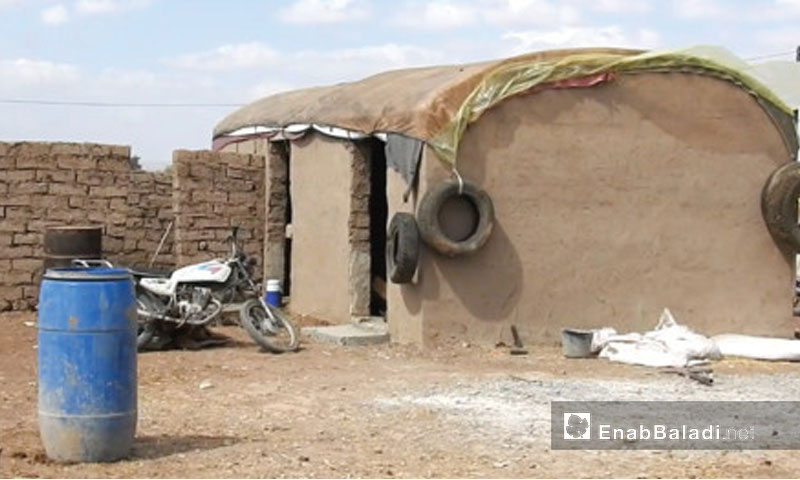



NORTHERN ALEPPO, SYRIA — In his tent in the town of Suran, in Aleppo’s northern countryside, Abu Mohammed couldn’t find a place to protect himself from summer’s heat or winter’s cold. He, thus, moved with his family to live in a mud house, which he managed to build all by himself after buying the basic needed materials, bricks made of mud mixed with hay.
In an interview with Enab Baladi, Abu Mohammed said “Mud houses, known as clay houses, are the only solution for the people living in tents, against the backdrop of the suffering they are going through, especially on winter starting with rainwater leaking to the covers and pillows they sit on.”
The price of a single mud brick is 50 Syrian Liras, which is better than cement bricks,” Abu Mohammed says. “In northern Aleppo, the price of a single cement brick is 150 Liras, while a single room made of mud might cost 60 thousand Syrian Liras. The thing which helps hundreds of the displaced people to build a simple house, one that relieves them from cold and rain, after more than three years of displacement and living in tents.” (The dollar is equivalent to 500 Syrian pounds)
“It is a necessity to build mud villages as a substitute for the camps in Aleppo’s northern countryside. The displacement issue has been there for a long time now, and the tent requires to be changed or maintained every year; contrastingly, a mud room lasts for a long time and is distinct for its ability to isolate the sun and other weather fluctuations.”
Most of the camps on the borders with Turkey include prefabricated caravans and canvas tents, making a home to the displaced people from the northern and eastern countryside of Aleppo, who left their homes after the battles with the Islamic State organization (IS) and the Syrian Democratic Forces (SDF) earlier.
The situation of Abu Mohammed is not different from that of Ahmad al-Ali, a resident of the village of Al-Adiya, in the north of the city. Ahmad also took refuge in mud houses away from the camps, where he has been a refugee for about two years. He said that he had built a house of mud with a weatherproof structure depending on the thickness of its walls and the materials, which the mud contains.
To Enab Baladi, he said that the mud contains two materials: Dirt and straw, hay. He indicated that the color of the soil should be black, which is mainly found on the old hills and some of the villages in the northern countryside.
The mud building’s roof consists of wooden poles, according to the young Ahmed, explaining that “nylon is placed on these poles because it’s lighter than concrete, in case of building the wall of one brick.”
If the built wall is three bricks thick, we can add concrete to the ceiling.
if you think the article contain wrong information or you have additional details Send Correction